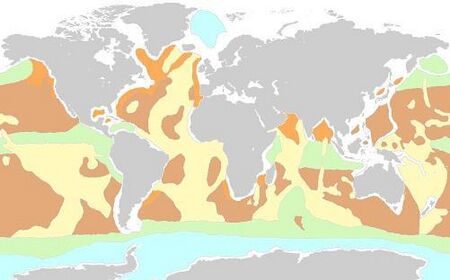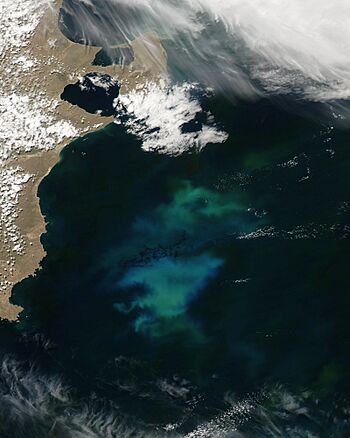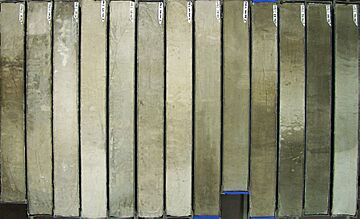Siliceous ooze facts for kids
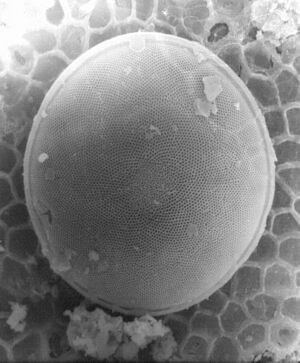
Siliceous ooze is a special type of mud found on the bottom of the deep ocean. It's a biogenic sediment, which means it's made from the remains of living things. This ooze is mostly made of the glassy skeletons of microscopic sea creatures, especially diatoms and radiolarians.
Imagine a soft, gooey mud made of countless tiny, intricate glass shells. That's siliceous ooze! It covers about 15% of the entire ocean floor. For a sediment to be called an "ooze," at least 30% of it must be these tiny skeletons.
The main ingredient in these skeletons is silica (SiO2), the same basic material found in glass and sand. This makes it different from another type of seafloor mud called calcareous ooze, which is made from the chalky, calcium carbonate skeletons of other sea creatures.
The location, water depth, and how many nutrients are in the water all affect where this special ooze can form.
Contents
How Does Siliceous Ooze Form?
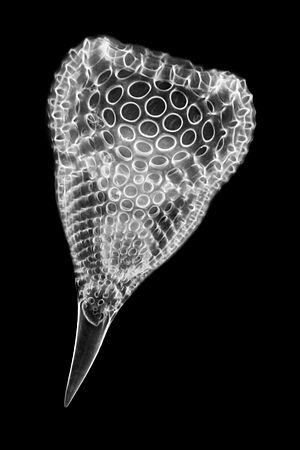
The creation of siliceous ooze is a long process that starts with tiny life in the sunny, top layer of the ocean and ends in the dark, deep sea.
Tiny Creatures Build Glass Houses
In the ocean, there are microscopic organisms like diatoms (a type of algae) and radiolarians (a type of protozoa). They are like tiny architects that build their own protective shells, or skeletons.
To do this, they pull a substance called silicic acid out of the seawater. Inside their bodies, they have special proteins that help them turn this acid into opal silica, which is a type of glass. They use this to build beautiful and complex skeletons.
The Long Journey to the Seafloor
When these tiny creatures die, their glassy skeletons begin to sink. It's a long journey from the surface to the deep ocean floor. Many of these delicate skeletons dissolve back into the water on their way down.
However, some skeletons get clumped together in what is called "marine snow" or are eaten and passed through larger animals. This packaging protects them and helps them sink faster, giving them a better chance of reaching the bottom.
Only about 4% of all the silica shells made at the surface actually make it to the seafloor. The other 96% gets recycled in the water above.
Building Up Over Time
Siliceous ooze builds up on the ocean floor very, very slowly. In some places, it might only build up a tiny fraction of an inch each year. The fastest buildup happens in the Southern Ocean around Antarctica. It can take 20 to 50 years for a single skeleton to sink and become part of the ooze layer.
Over millions of years, as layers of ooze get buried deeper and deeper, the pressure and heat can turn the ooze into a hard rock called chert.
Where Is Siliceous Ooze Found?
Siliceous ooze doesn't form everywhere. It is most common in areas of the ocean called upwelling zones. In these zones, deep, cold water rich in nutrients rises to the surface. These nutrients act like fertilizer for diatoms and radiolarians, allowing them to thrive.
Major locations for siliceous ooze include:
- The Southern Ocean: A huge band of siliceous ooze circles the entire globe around Antarctica.
- The Pacific Ocean: A strip of ooze is found near the equator, and more is found in the North Pacific.
- Near Coasts: It can also be found where strong ocean currents, like the Humboldt Current off South America, bring nutrients to the surface.
Scientists often categorize the ooze by what it's mostly made of.
- Diatomaceous ooze is mostly made of diatom skeletons. It's usually found in colder waters, like the Southern Ocean and North Pacific.
- Radiolarian ooze is mostly made of radiolarian skeletons. It's typically found in warmer, tropical waters.
A Key Part of the Ocean's Silica Cycle
The ocean has a giant recycling system for silica, and siliceous ooze is a huge part of it. Think of it like this:
- Diatoms and radiolarians use silica from the water to build their shells.
- When they die, most of their shells dissolve, putting the silica back into the water for new creatures to use.
- A small amount of the shells sink to the bottom and become ooze. This is the largest long-term storage of silica in the ocean.
- Even on the seafloor, much of the silica in the ooze dissolves and is eventually brought back to the surface by ocean currents.
This whole cycle, from creature to ooze and back again, can take about 400 years. Each molecule of silica might be recycled 25 times before it is finally buried and locked away in rock.
How Ooze Can Affect Climate
Diatoms are not just pretty; they are also very important for our planet's health. Like plants on land, they perform photosynthesis. This means they take carbon dioxide (CO2), a greenhouse gas, from the atmosphere and turn it into organic carbon.
When diatoms die and sink, they carry this carbon with them to the deep ocean. This process is called the biological pump, and it helps lock away carbon that would otherwise warm our planet. Because their glassy shells are heavy, they help the diatoms sink faster, making this process more efficient.
Scientists have even experimented with adding iron, a nutrient that diatoms need, to parts of the ocean. The hope was to create a "bloom" of diatoms that would absorb more CO2. These experiments showed that while more diatoms grew, it's a very complex process to get that carbon stored permanently in the deep sea.
A Window into the Ocean's Past
Old layers of siliceous ooze, called paleo-ooze, are like a history book of the ocean. Scientists called paleoceanographers drill long tubes of mud, called sediment cores, from the seafloor to study these layers.
Each layer tells them about the ocean's conditions at a certain time in the past. By looking at the types of skeletons and the thickness of the ooze layers, scientists can learn about past climates, ocean currents, and major events in Earth's history.
For example, the fossil record in the ooze shows that radiolarians are very ancient creatures that appeared hundreds of millions of years ago. Diatoms evolved much later, but their appearance had a huge impact. They began using up large amounts of silica and storing massive amounts of carbon, changing the chemistry of the entire ocean and even the air we breathe.
By studying these ancient oozes, scientists can understand how our oceans have changed over millions of years and how they might change in the future.
See also


